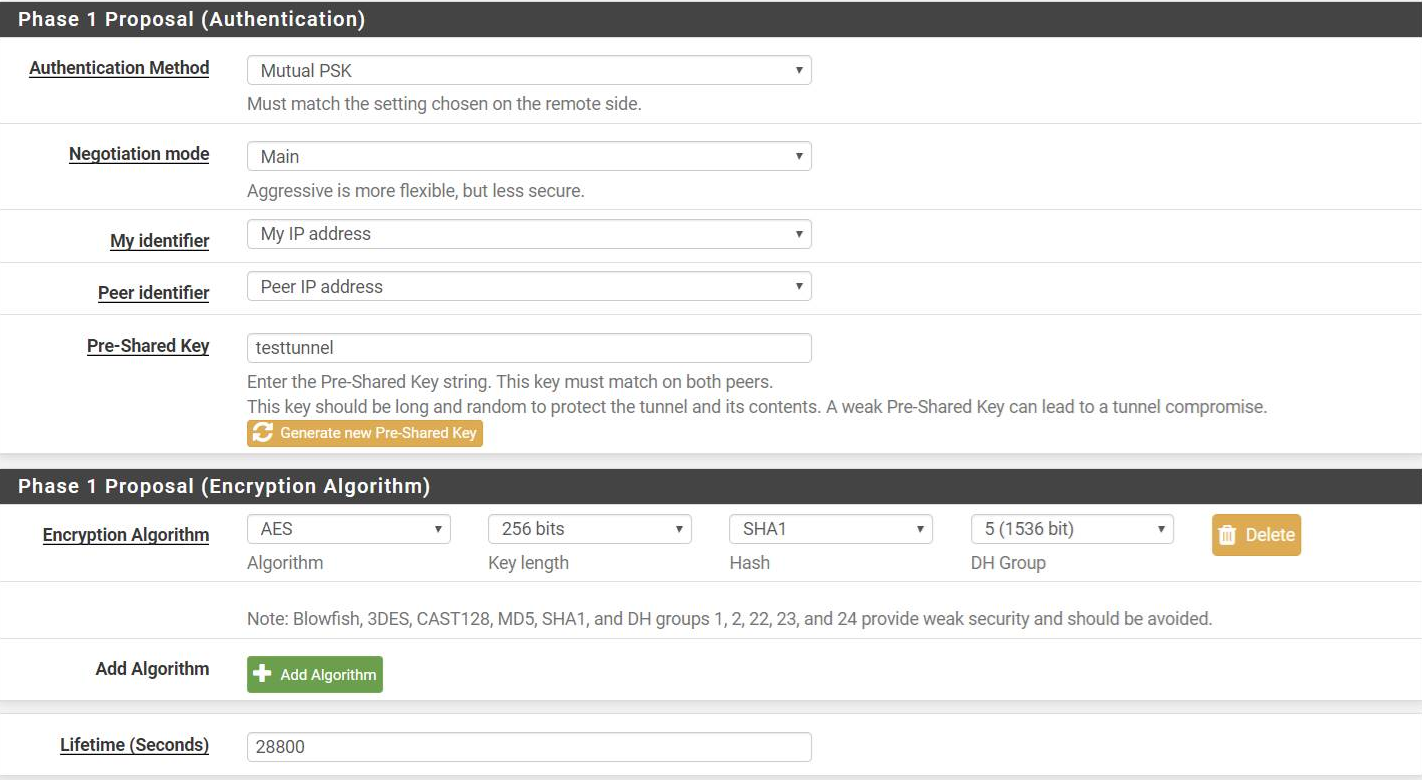IPSEC Site To Site
-
Hello everyone, we are new to the Netgate Community
Anyone got any ideas on this?
We are trying to connect a VPN tunnel from a Cisco RV042 router to a Netgate XG-7100 Router. Every time we try to make the connection the XG-7100 says that there is a missing DH Group proposal even though we have it configured properly on the XG-7100.
Here are some of the Logs:
Aug 5 16:12:36 charon 08[IKE] <9> is initiating a Main Mode IKE_SA
Aug 5 16:12:36 charon 08[IKE] <9> IKE_SA (unnamed)[9] state change: CREATED => CONNECTING
Aug 5 16:12:36 charon 08[CFG] <9> selecting proposal:
Aug 5 16:12:36 charon 08[CFG] <9> no acceptable DIFFIE_HELLMAN_GROUP found
Aug 5 16:12:36 charon 08[CFG] <9> selecting proposal:
Aug 5 16:12:36 charon 08[CFG] <9> no acceptable ENCRYPTION_ALGORITHM found
Aug 5 16:12:36 charon 08[CFG] <9> received proposals: IKE:AES_CBC_256/HMAC_SHA1_96/PRF_HMAC_SHA1/MODP_1536
Aug 5 16:12:36 charon 08[CFG] <9> configured proposals: IKE:AES_CBC_128/AES_CBC_192/AES_CBC_256/CAMELLIA_CBC_128/CAMELLIA_CBC_192/CAMELLIA_CBC_256/3DES_CBC/HMAC_SHA2_256_128/HMAC_SHA2_384_192/HMAC_SHA2_512_256/HMAC_SHA1_96/AES_XCBC_96/AES_CMAC_96/PRF_HMAC_SHA2_256/PRF_HMAC_SHA2_384/PRF_HMAC_SHA2_512/PRF_AES128_XCBC/PRF_AES128_CMAC/PRF_HMAC_SHA1/ECP_256/ECP_384/ECP_521/ECP_256_BP/ECP_384_BP/ECP_512_BP/CURVE_25519/MODP_3072/MODP_4096/MODP_6144/MODP_8192/MODP_2048, IKE:AES_GCM_16_128/AES_GCM_16_192/AES_GCM_16_256/AES_GCM_12_128/AES_GCM_12_192/AES_GCM_12_256/AES_GCM_8_128/AES_GCM_8_192/AES_GCM_8_256/PRF_HMAC_SHA2_256/PRF_HMAC_SHA2_384/PRF_HMAC_SHA2_512/PRF_AES128_XCBC/PRF_AES128_CMAC/PRF_HMAC_SHA1/ECP_256/ECP_384/ECP_521/ECP_256_BP/ECP_384_BP/ECP_512_BP/CURVE_25519/MODP_3072/MODP_4096/MODP_6144/MODP_8192/MODP_2048
Aug 5 16:12:36 charon 08[IKE] <9> no proposal found
Aug 5 16:12:36 charon 08[IKE] <9> queueing INFORMATIONAL task
Aug 5 16:12:36 charon 08[IKE] <9> activating new tasks
Aug 5 16:12:36 charon 08[IKE] <9> activating INFORMATIONAL task
Aug 5 16:12:36 charon 08[ENC] <9> generating INFORMATIONAL_V1 request 1058529224 [ N(NO_PROP) ]
Aug 5 16:12:36 charon 08[NET] <9> sending packet: from XXX.XXX.XXX.XXX[500] to XXX.XXX.XXX.XXX[500] (56 bytes)
Aug 5 16:12:36 charon 08[IKE] <9> IKE_SA (unnamed)[9] state change: CONNECTING => DESTROYING
Aug 5 16:12:36 charon 08[NET] <con2000|8> received packet: from [500] to XXX.XXX.XXX.XXX[500] (56 bytes)
Aug 5 16:12:36 charon 08[ENC] <con2000|8> parsed INFORMATIONAL_V1 request 1058529224 [ N(NO_PROP) ]
Aug 5 16:12:36 charon 08[IKE] <con2000|8> received NO_PROPOSAL_CHOSEN error notify
Aug 5 16:12:36 charon 08[IKE] <con2000|8> IKE_SA con2000[8] state change: CONNECTING => DESTROYINGWhat we are seeing that there is no MODP_1536 which is DH Group 5. Unfortunately the Cisco RV042 only uses DH Groups 1, 2, and 5. And from what you can see in the logs above, MODP_1536 doesn't show up in the configured proposals list.
We also have a second XG-7100 for our data center and the IPsec VPN works fine on that one and the list of configured proposals shows MODP_1536. So two identical routers and one is working properly with the IPsec VPN and the other isn't. They both have the same current pfSenseSystem Versions 2.4.4_3
Here's a screenshot of our XG-7100 Config.

Anyone ever seen this type of behavior before?
Thanks and if you need more info from us, just let us know.
-
Yeah. it is probably not matching the Phase 1 for some reason so it is not using your selected proposals for that connection.
Post everything from the first packet received.
-
Derelict thanks for the fast response.
Since we are so new to pfSense and Netgate, what is the best way to do this? Logs from the XG-7100 or do we need to use wireshark on the PC we are trying to initiate the tunnel on the Cisco router? We are using a laptop connected to the Cisco router to log into the router and then try to initiate the VPN tunnel to the XG-7100 that is giving us the problem.
Thanks,
-Jeff
-
Complete logs is what I was talking about.
-
Derelict, again thanks for helping out here.
I actually just figured it out about 30 mins ago and I think I've solved the issue. And being new to the pfSense software it ended up being a configuration issue due to some of the testing we have been going through with these units over the past couple of weeks. So I finally tracked down the config differences between the two routers and had that aha moment. Changed/removed the configs on the router that was acting up and the tunnel connected no problem.
Long story short is that we had set up some test virtual IP's on the one XG-7100 router and the Cisco router that we were using to test theses IPsec tunnels is set up using the same WAN IP as we had set up as a virtual IP on the one XG-7100 that was giving us the issue. So I removed the virtual IP and there you go, the tunnel connects fine. So I think we should be good to go, (hopefully).
Thanks again for the quick responses!
-Jeff
-
Virtual IP should not matter unless the IPsec was set to use it.
In any case glad you found it.
-
Ok, thanks for the info and we will keep that in mind. Being so new to pfSense, we have a long learning curve ahead of us.
-
Don't know if I should ask this here or not since this is resolved, but in pfSense with point to point IPsec tunnels, will they come back up automatically after a reboot or something like that, or do you have to go in and manually initiate the connection again?
-
Each side should initiate when there is traffic matching the traffic selector.
In many cases you can make this happen by setting an automatically ping host to something on the other side in each P2. (it just has to match the remote network - it doesn't actually have to respond to ping).
Tunnels generally come up very quickly and the fact that the tunnel was not actually up when the traffic is initiated is not noticed by users or applications.